The most enduring and perhaps the greatest form of visual art known to man, sculpture has played an important role in the evolution of Western culture. Its history and stylistic development belong to Western art itself. It was a key indicator of the cultural achievements of classical antiquity and became an important factor influencing the development of Renaissance art in Italy. Together with architecture, it was the main form of monumental religious art, which for centuries (c. 400-1800) was the driving force of European civilization. Even today, although sculpture is constantly evolving, it is still the leading method of expressing and immortalizing historical figures and events.
Magnificent examples of this long-standing form of public art can be found in many of the finest art museums.
Also known as “plastic art,” sculpture should be fairly easy to define, but unfortunately it is not.
The ever-expanding art form
That’s because the definition or meaning of sculpture has greatly expanded during the 20th century. With the development of new sculptural tools and technologies, contemporary works now use such a huge variety of new materials, techniques and spatial reference systems that “sculpture” is no longer a fixed term that refers to a fixed category of objects or creative activity. Rather, it is an ever-expanding art form that is constantly evolving and redefining itself.
Definition of traditional sculpture
Traditional sculpture prior to the 20th century had four main defining characteristics. First, it was the only three-dimensional art form. Second, it was the most representative. Third, it was seen as a solid form art. Any empty spaces involved were essentially secondary to its volume or mass. Fourth, traditional sculptors used only two basic techniques: carving or modeling. That is, they either carved directly from a chosen material (e.g., stone, wood) or built the sculpture from within, so to speak, using clay, plaster, wax, and the like.
Definition of Modern Sculpture
The art of sculpture is no longer limited to traditional sculptural concepts, materials, or production methods. It is no longer exclusively representational, but often completely abstract. And yet, sculpture is not exclusively solid and static: it can be part of empty space, it can also be kinetic and capable of movement. Finally, in addition to being carved or modeled, it can also be assembled, glued together, projected (holographically) or constructed in various ways. As a result, the traditional four-digit meaning and definition of sculpture no longer applies.
